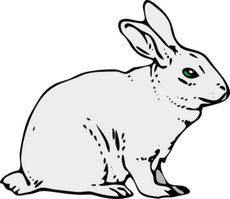
1. What are some VARIABLES that you have control over in the simulation?
2. What happens to the bunny population if a friend is never added? What happens when you add a friend?
3. What happens when you add food as a selection factor?
4. What is the difference between the arctic and equator environment?
5. What is a genetic mutation? What are the three mutations you can add to your bunny population?

Hypothesis: Natural selection will favor traits that _________________________________________
Complete the following simulations to answer your experimental question. Jot down notes for each with what happened.
Add a friend and a brown fur mutation to the bunny population, let the experiment continue to its conclusion.
Start over and add brown fur mutation (with friend) but add a selection factor of wolves when your bunnies start to get overpopulated. Let the experiment run until you have a clear idea of what is happening with the rabbit and wolf populations.
Change the settings so that you still have brown fur mutations but this time remove the wolves and make the selection factor be food. Let the experiment run until you have a clear idea of what is happening within the population.
Reset and change the settings so that you have brown fur mutation in an arctic environment, use wolves as your selection factor.
6. Based on the four simulations you ran, describe what happened to your population and answer the experimental question, consider what happens in both environments and what happens when there are no predators. Provide evidence from the simulation to support your conclusions.
7. Following the guidelines from the Experiment A, determine when long teeth provides an advantage to the bunny population. Run simulations in a variety of settings. Write the answer to your experimental question and then provide evidence for your answer from the simulation.
EVIDENCE (specific details and observations that support claim)
REASONING (discuss WHY your evidence supports the claim, include biological principles as reasoning for outcome)
8. Using the simulation, determine the conditions when a long tail would be an adaptation. If you cannot discover this from the simulation, propose any possible situation where a long tail would provide a selective advantage for bunnies and explain WHY it would be an advantage.
9. The process of evolution results from four known factors, for each listed, describe how those factors were observed in the simulation
| Factors that results in Evolution | Observations |
| Potential for a species to increase in number | |
| Heritable genetic variation | |
| Competition for limited resources | |
| Proliferation of organisms that are better able to survive and reproduce |
HS- LS4-2 Construct an explanation based on evidence that the process of evolution primarily results from four factors: (1) the potential for a species to increase in number, (2) the heritable genetic variation of individuals in a species due to mutation and sexual reproduction, (3) competition for limited resources, and (4) the proliferation of those organisms that are better able to survive and reproduce in the environment